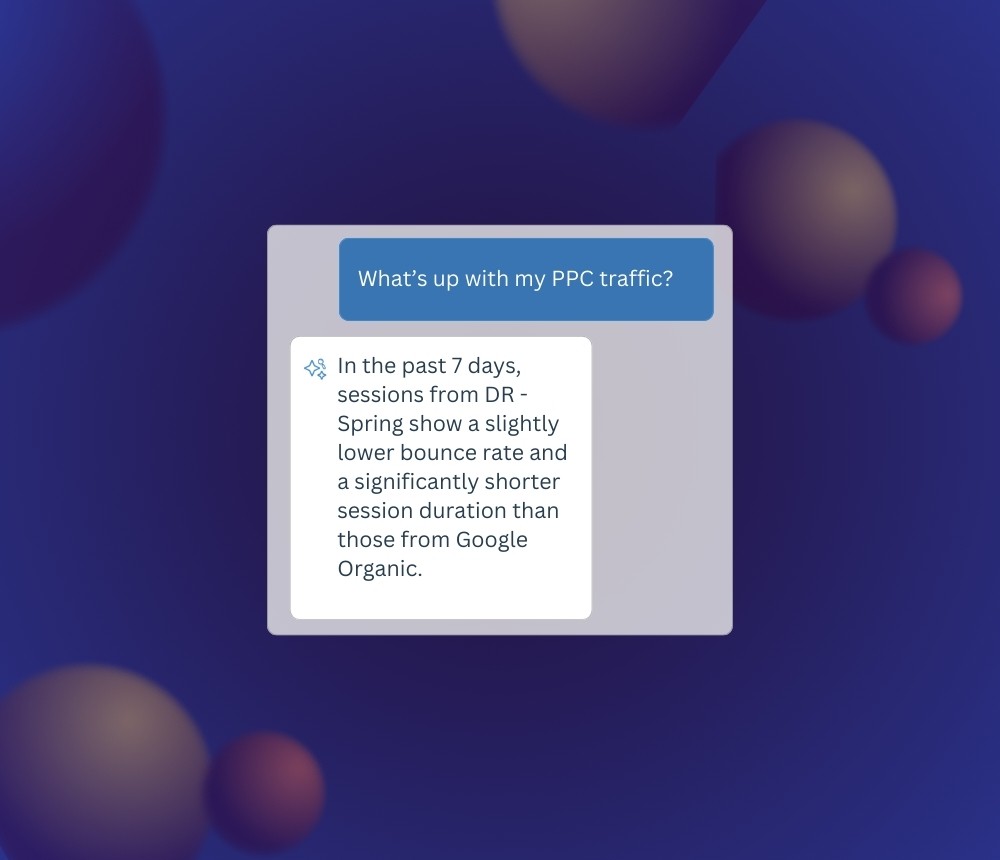Avoid Data Tsunami: Guide to Actionable Insights

From the beginning of time – 18,000 BCE to be exact – humans have been recording and consuming information.
Over the last 16,000 or so years, we’ve evolved from making tallies on a bone detailing trading activity to the launch of internet. According to IBM Marketing Cloud, 90% of the world’s data was created between 2014 and 2016, amounting to a staggering daily 2.5 quintillion bytes of data.
There’s no doubt we are in an information influx.
To marketers battling a tsunami of data that doesn’t come as a surprise. But what is a marketer in 2021 and beyond to do?
Recently, Sarah Bond, senior director of marketing strategy at Lucky Orange, presented at the Digital Summit Kansas City in Overland Park, Kansas, and shared insights on how to manage the vast amounts of data available and how to use that data to drive meaningful change.
So how do we avoid being overwhelmed and use this information to impact our businesses? Let’s dive into Sarah’s Top 5 recommendations.
No. 1: Ditch the antiquated metrics
Long gone is the time to focus on vanity metrics including:
Website analytics that measure last-click attribution, blog post page views and search rankings.
Determining marketing campaign success by impressions, open rates, pageviews and subscribers.
Follower counts, post quantity, earned media value (EMV) and social media shares and likes.
What do you focus on instead?
The answer: Instead of outdated metrics, think like high-performing organizations. These businesses orient their reporting around data points such as lifetime customer value, customer satisfaction metrics, revenue growth and marketing qualified leads.
In its State of Marketing fifth edition, Salesforce outlined the various types of metrics that marketers use to evaluate their campaign and initiative performance.
The important thing to note is that although some marketers are still using vanity metrics, those that are considered high-performing marketing organizations are focusing instead on marketing metrics that impact customer service or have an impact on their organization’s bottom line.
No. 2: Segment your analytics
There are hundreds of ways you can segment your marketing analytics. Whether you choose to segment by campaigns, traffic sources, persona/market, buyer stage/life cycle, acquisition channel, etc., make the determination of what is most relevant to your business and hone in on that aspect.
For example, you can segment your data to show you data just for Facebook traffic or visitors who came to your website five times before converting.
A great example of this is how Lucky Orange customer MyBaitShop.com used Lucky Orange’s heatmaps and session recordings tools to see how traffic from Facebook campaigns interacted different from other traffic sources.
By using Lucky Orange, Keith Bell, the owner of MyBaitShop.com learned traffic from Facebook ads seemed to be performing better at first, but eventually leveled off. This was helpful information that Keith could use to direct advertising spending for future campaigns.
“When looking at our traffic with Lucky Orange, we were able to see our traffic pattern of our visitors in real time via recordings,” Keith said. “We could see exactly where visitors left and what the pain points were. With paid traffic we could see exactly what we were getting for our money. For example, if they just browsed one page or looked around awhile.”
You can check out the full case study with MyBaitShop.com on the Lucky Orange blog to learn more helpful tips on how Keith uses Lucky Orange to boost conversion rates to his Shopify store.
No. 3 Know what impacts the bottom line
Another important way to avoid being overwhelmed by the amount of marketing analytics data your campaigns produce is to focus on aspects that allow you to show how your campaigns impact the bottom line.
Our friends over at Web Canopy Studio, an inbound marketing agency and Hubspot Diamond Agency Partner, use marketing qualified leads (MQLs) as a way to determine if their marketing efforts are moving the meters for their business and for their clients.
Measuring campaign performance by the number of MQLs generated allows you to show how several different marketing initiatives worked together to drive an action rather than focusing, say, on how many engagements your social campaign alone drove.
MQLs aren’t a one-size-fits-all metric for marketing performance, though. If your organization doesn’t use MQLs, work with your organization’s leaders to understand what activities can truly impact the bottom line and use marketing metrics that show how you impact those factors.
No. 4: Dashboard and repeat
Through leveraging a dashboard to track, analyze and compare your data across your marketing campaigns, you will be able to quickly review the data to make informed decisions.
But before you start grabbing data from Lucky Orange or other analytics platforms you might be using, you need to get the right stakeholders in the room for a brainstorming session. Gather your peers and those who have insight into your organization’s leaders together to gain a better understanding of the following:
What questions are you trying to answer with your data?
Who is your audience?
What does the audience care about most?
What sources do you need to tap into for data?
How and where will the data be shared?
Once you have the answers to these questions, you can start formulating a list of questions you want to answer across different areas.
The important thing to remember is you should already have a hypothesis around what your marketing data will show before you start pulling data. This will help you narrow in on the data you need to answer the right questions and keep you from creating a dashboard that’s a dump of data point.
Once you’ve determined the data to include on your dashboard, think about how your audience will consume that data. Do you need to package it in a PDF that can be sent via email or will an online dashboard platform like Databox or Tableau work for you?
If you’re looking for a dashboard platform that can aggregate lots of different data sources, check out Scott Brinker’s Marketing Technology Landscape Supergraphic. There’s a quadrant on dashboards and data visualizations that can be a great place to start your dashboard provider search.
No. 5: Show the trendline
Understanding how your marketing analytics fit into the bigger picture is table stakes when it comes to effective reporting. For marketing analytics information to be truly meaningful, marketers need to focus on more than simple data points or point-in-time reporting.
Examples of putting your data into a bigger picture context include:
Comparing how your marketing efforts are performing week-to-week, month-to-month or from season to season
Evaluating the efficacy of different marketing channels against one another to see which mediums are driving the most impact for your business
Seeing how your campaigns are performing over time compared to your competitors
Looking not only at how you compare relative to your competitors but also against companies of similar market cap or size in industries outside of your primary business. Especially for marketers, this can help validate whether your team is performing against some best-in-class companies.



